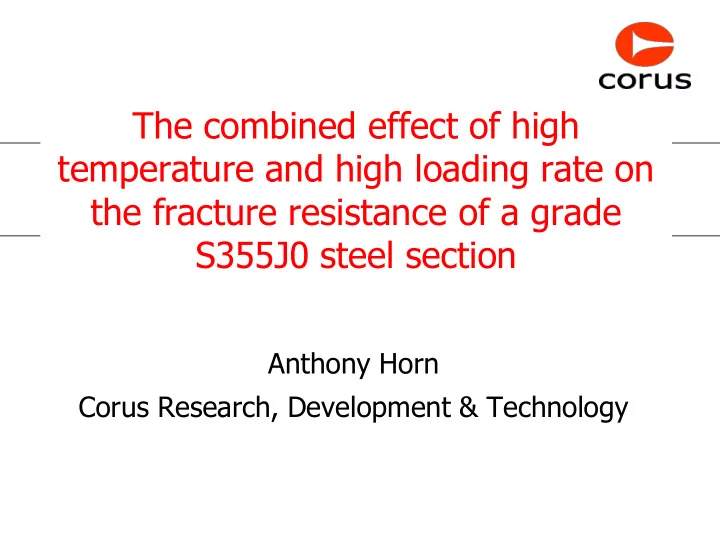

The combined effect of high temperature and high loading rate on the fracture resistance of a grade S355J0 steel section Anthony Horn Corus Research, Development & Technology
Introduction • Structural integrity assessment techniques require definition of: – Resistance (e.g. strength, toughness) – Demand (e.g. stress, crack driving force) • When Demand>Resistance, failure predicted • For extreme loading conditions, resistance is a function of demand, e.g. – strength and toughness are both functions of applied strain rate and temperature 2
Objective • To characterise how material toughness of a Corus section changes over: – a range of temperatures from ambient to +550°C – a range of loading rates from quasi-static to impact – a combination of the two • Benefit: – to enable fracture mechanics assessments to be made under conditions of high temperature, high strain rate, or a combination of both 3
Methodology J • Fracture resistance characterised using J-Resistance curves J 0.2 Ductile crack extension Δ a 0.2mm • Quasi-static loading rates: – compact tension (CT) specimens tested and analysed in accordance with ASTM E1820-09 • Intermediate and high loading rates: – pre-cracked Charpy (PCV) specimens tested in accordance with ISO14556 – test results analysed using ISO/FDIS 26843 to obtain J-R curves 4
Material investigated • Grade S355 J0 structural steel – manufactured by Corus • 457 x 191x 89 UB section • Flange thickness 17.7mm • Yield stress 396MPa, UTS 520MPa All specimens machined with 1/6 W crack tip at 1/6 th flange width 1/6 W (1/6FW) position W 5
Test Matrix Specimen Rate Room T +200°C +400°C +550°C Compact Quasi-static 2 4 4 2 Tension 25° drop angle 3 3 3 3 Pre-cracked Charpy 45° drop angle 3 3 3 3 specimens 150° drop angle* 3 3 3 3 6
Test Matrix Specimen Rate Room T +200°C +400°C +550°C Compact Quasi-static 2 4 4 2 Tension 25° drop angle 3 3 3 3 Pre-cracked Charpy 45° drop angle 3 3 3 3 specimens 150° drop angle* 3 3 3 3 7
Measured J-R curves: Quasi-static loading rate +400°C (solid lines) 400 Room temperature 350 (dotted lines) +550°C 300 (dashed J (kJ/m²) 250 lines) 200 150 100 +200°C 50 0 0.0 0.5 1.0 1.5 2.0 8 Δa (mm)
Measured J 0.2 values: Quasi-static loading rate • Dip in values observed in tests at +200°C 120 100 J 0.2 (kJ/m²) 80 60 40 20 0 0 100 200 300 400 500 600 9 Temperature (°C)
Test Matrix Specimen Rate Room T +200°C +400°C +550°C Compact Quasi-static 2 4 4 2 Tension 25° drop angle 3 3 3 3 Pre- cracked 45° drop angle 3 3 3 3 Charpy specimens 150° drop angle* 3 3 3 3 10
Measured J-R curves: High loading rate • Measured using pre-cracked Charpy specimens at 150° drop angle Room temperature 700 +200°C 600 +400°C 500 J (kJ/m²) +200°C 400 +550°C 300 200 100 0 0.0 0.5 1.0 1.5 2.0 11 Δa (mm)
Measured J 0.2 values: All loading rates • Dip in J 0.2 values only evident at quasi-static loading rates J 0.2 12
Conclusions 1. At all temperatures studied, tearing resistance increases with increasing loading rate J 0.2 13
Conclusions 2. At intermediate loading rates, tearing resistance decreases linearly with increasing temperature J 0.2 14
Conclusions 3. At high loading rates, tearing resistance is approximately independent of temperature up to +400°C before dropping sharply J 0.2 15
Conclusions 4. At quasi-static loading rates, there is a dip in tearing resistance at +200°C due to dynamic strain ageing J 0.2 16
Conclusions 5. There is a trade- off between the ‘beneficial’ effect of high strain rate and ‘detrimental’ effect of high temperature J≈100 kJ/m² J 0.2 J ≈ 100 kJ/m² 17
Thank you for your attention Any questions?
Recommend
More recommend